
- •Acknowledgments
- •About the Author
- •Credits
- •Contents at a Glance
- •Contents
- •Introduction
- •About This Book
- •Assumptions
- •How This Book Is Organized
- •Conventions Used in This Book
- •Hacking Precautions
- •Customizing the Logon Screen
- •Summary
- •Customizing the Start Panel
- •Customizing the Classic Start Menu
- •Customizing the Taskbar
- •Summary
- •Customizing Desktop Icons
- •Customizing the Behavior of the Desktop
- •Summary
- •Working with Themes
- •Modifying the Visual Styles
- •Visual Style Alternatives
- •Summary
- •Hacking File Associations
- •Hacking the Context Menu
- •Customizing Your Folders
- •Working with Hidden Files
- •Disabling the Common Tasks Pane
- •Summary
- •Modding Internet Explorer
- •Other Visual Enhancements
- •Summary
- •Monitoring Your System Hardware
- •Benchmarking Your System
- •Summary
- •Working with BIOS
- •Modifying the Operating System Boot
- •Summary
- •Speeding Up the Logon
- •Summary
- •Speeding up file browsing and access
- •Speeding Up the User Interface
- •Summary
- •Working with the Windows Prefetcher
- •Using the Intel Application Accelerator
- •Defragmenting Your Drive
- •Adjusting Your Application Priorities
- •Speeding Up Your Network
- •Summary
- •Summary
- •Defending against Viruses
- •Defending Spyware and Adware
- •Eliminating Spam
- •Summary
- •Controlling access to your computer
- •Wireless Networks
- •Disabling Unneeded Services
- •Firewalls
- •How Vulnerable Is Your System?
- •Internet Explorer
- •Windows Interface
- •Summary
- •System Requirements
- •Using the CD with Windows XP
- •Troubleshooting
- •Index

142 Part I — Customizing Your System
FIGURE 6-4: Creating an address bar command.
You are now finished and can close Tweak UI. To test your new command, just open up a new instance of IE and type in Google search terms. You should be taken to Google with your search terms displayed as the results.
If you like the new command, you can always make more for other search engines or for quick links to Web sites. I also like to create a command called weather. I just type in weather followed by a ZIP code and then am taken to the weather channel’s site. To make this work, I have my URL set to http://www.weather.com/weather/local/%s.
Other Visual Enhancements
A few more hacks and utilities can enhance and customize the different visual elements even further. These next few sections will show you some great apps that will add interesting special effects to your user interface as well as a few hacks that will help you fine-tune other elements of your computer.
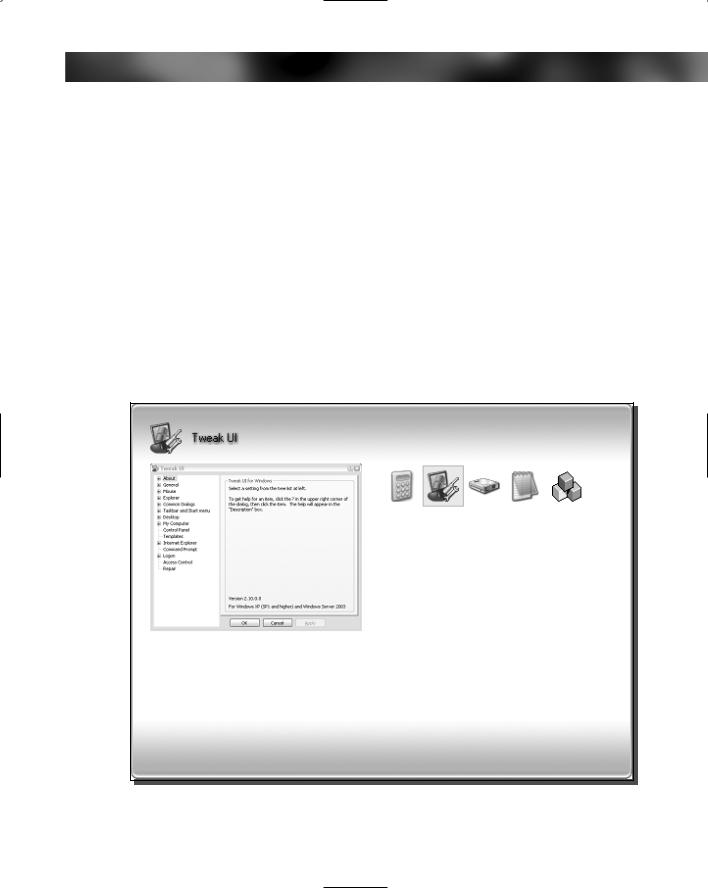
Chapter 6 — Exploring Other Windows Enhancements 143
Replacing the task switcher
The task switcher is the little application that pops up when you press Alt and Tab to switch between active applications. To use it, just hold down the Alt key and press Tab. Then keep the Alt key held down and tap the Tab key to select a different app to switch to. The task switcher is a no-thrills app that just shows you the icon and the name of the application when it is displayed. Most people rarely use the task switcher to switch between programs because the taskbar is usually much easier. However, Microsoft has released a new PowerToy that is a replacement for the task switcher that might make you think twice about using the taskbar to switch between apps because of its cool new appearance and features.
The new replacement task switcher, shown in Figure 6-5, is updated to reflect the new XP look and includes a new image preview of the application that you can switch to. Operating the replacement task switcher is exactly the same, just use Alt and Tab.
Now that you know a little about the new task switcher, it’s time to get it installed on your computer. Installing it on your computer is very easy. Just download a copy of the app from the PowerToys Web site, located at http://www.microsoft.com/windowsxp/pro/down
FIGURE 6-5: Microsoft’s new Alt Tab replacement.

144 Part I — Customizing Your System
loads/powertoys.asp. It is located on the top of the list on the right side of the page. When you have finished downloading it, open up the file and keep clicking Next to install it. When the installation exits, the new task switcher is ready to be used without a system reboot. Just click the Alt and Tab keys to see the new task switcher on your computer. Remember, the task switcher will not function if you have just one app open. It requires a minimum of two applications to be open in order for it to work. After all, why would you need to switch between apps if you have only one app open?
Adding Special Effects to your Windows
Thousands of tiny apps are available on the Web that will add both visual effects and features to your windows. Three nifty apps are a must for any user who is interested in customizing her or his computer and making it unique. I have selected a few of my favorite apps that represent several different special effects, such as animation, fades, shadows, and more.
Using WindowsFX
WindowsFX is a program developed by Stardock that offers a suite of special effects that will help make your computer look great. It gives users the ability to add drop shadows on all active windows, window transitions, and transparency. But the most impressive feature, and the reason why I am including this app, are the animations that appear when you drag a window around on the screen. As shown in Figure 6-6, when you drag a window across the screen, the window has an effect as if it is some sort of gelatin.
This is an effect that you will really have to experience first hand to understand. Therefore, follow these steps to get WindowsFX installed on your computer and the dragging effect up and running:
1.Visit Stardock’s Web site at www.stardock.com/products/windowfx/ and download a copy of WindowsFX.
2.Once you have WindowsFX installed, start it up by expanding the Object Desktop entry in the All Programs menu and select WindowsFX.
3.Under the side menu for 2000 / XP Only, select Window Dragging to bring up the settings.
4.On the Window Dragging screen, select Basic Swaying Windows, as shown in Figure 6-7.
5.Once you have selected Basic Swaying Windows, click Apply Changes, located in the lower-left portion of the window just under WindowFX.
Once you have applied your changes, you will notice the new effect when you drag windows around on the screen. A lot of different dragging effects are available that you can use, but unless you purchase the full version of the app, those will not be available to you.
Adding shadows to your windows
Drop shadows are a cool feature to add to your windows. They make your applications stand out a lot more when you have a lot of windows open and make Windows XP look like OSX or
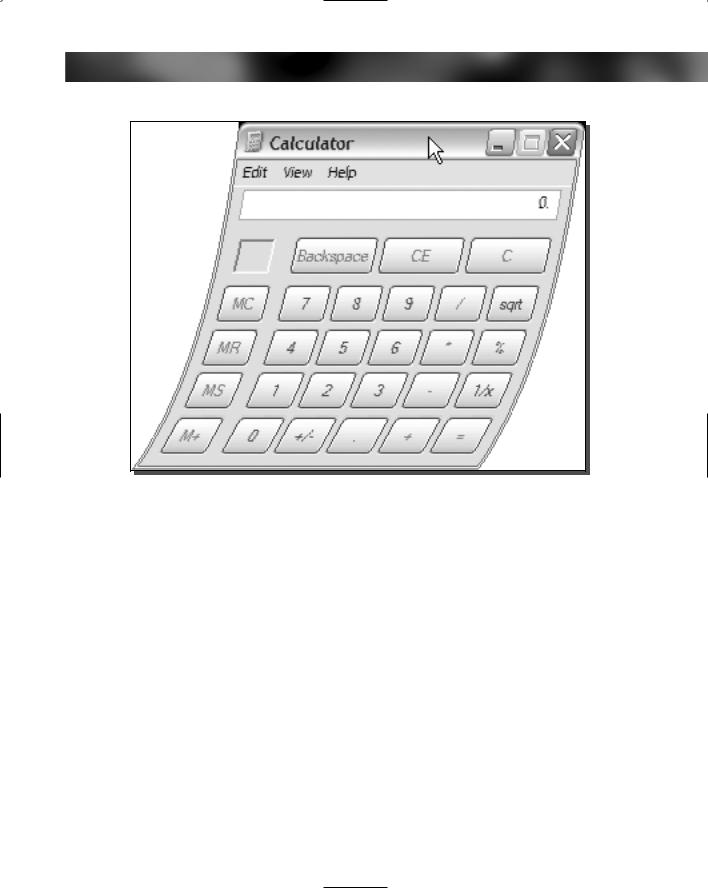
Chapter 6 — Exploring Other Windows Enhancements 145
FIGURE 6-6: WindowsFX’s animated drag.
as they are expected to look in Longhorn, the next Windows operating system due out within a few years. Drop shadows are possible through a variety of applications on the Web. My favorite application to use for this is called Lokai Shadows XP. This free application, written by Brandon Sneed, can be downloaded from his Web site at http://redf.net/download.php?view.2. One of the reasons why I like this application so much is because it works (a lot of them I could not get to work) and because it also can run as a service in the background. The quality of the drop shadows on the windows is also of high quality, as shown in Figure 6-8.
Visit the author’s Web site and download a copy of Lokai Shadows XP and follow these steps to install the app and get it up and running:
1.Once you have downloaded Lokai Shadows XP, extract the ZIP file to a permanent home on your hard drive. Make sure that you do not put it in a directory that has a space in the name or else you will have a problem with step 2.
2.Now that you have extracted the files for the app, you have to register it on your computer as a service. Let’s assume that you extracted the shadow app to c:\ShadowXP. Click the Start button and select Run. Then type c:\ShadowXP\ lokaishadow_svc.exe /install in the box and click OK. If everything went OK, then you should get a pop-up confirmation box telling you it was installed successfully.
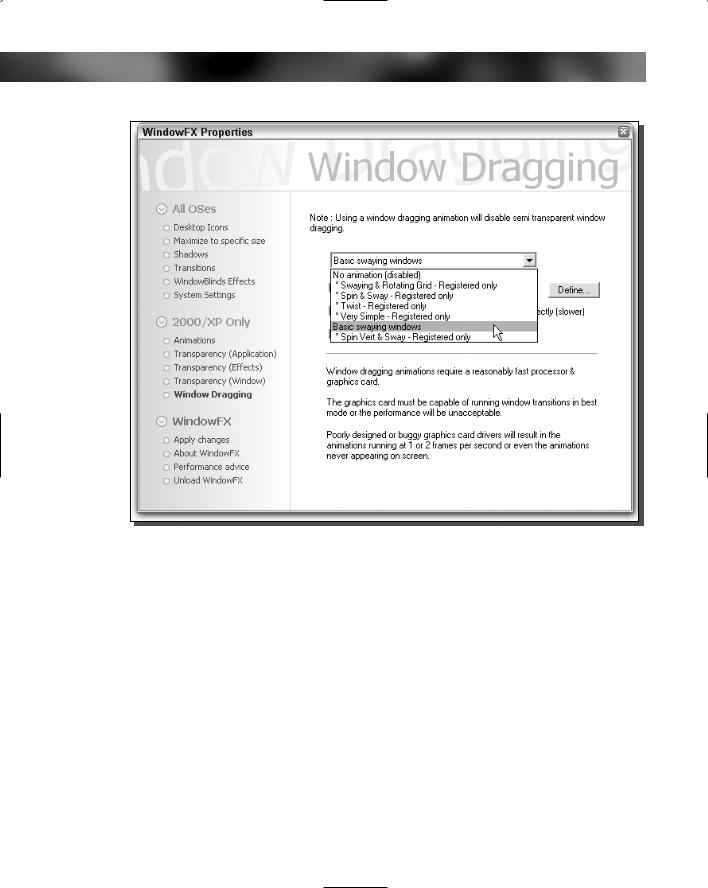
146 Part I — Customizing Your System
FIGURE 6-7: Selecting Basic Swaying Windows to enable the dragging animation.
3.Now that you have registered the service, turn it on. Click the Start Menu again and select Run. Type services.msc in the box and click OK.
4.The Services dialog box should load. Look through the list of services and right-click Lokai Shadows XP and select Start.
5.Close the Services dialog box and you are finished.
After the service is started, any new windows that you open up will automatically have drop shadows displayed. Also, do not worry about having to manually start the service each time you turn on your computer. By default, the service is set to Automatic. That tells the computer to start it up every time the computer boots.
Using Glass2k to make your windows transparent
Would you like to see through your windows? Do you often have to rearrange windows on the screen to get to information that is hidden below another window? I always run into that

Chapter 6 — Exploring Other Windows Enhancements 147
FIGURE 6-8: Lokai Shadows XP in action.
problem when I am doing a lot of tasks on my computer at once. Being able to make a window or application transparent, as shown in Figure 6-9, by just clicking a few hotkeys on your keyboard is an easy and cool-looking solution to that problem.
Windows XP has transparency, also known as alpha settings, built into the operating system but it does not use any of these features on windows or the taskbar. Programs that add the transparency capability are just turning this feature on for use on other parts of the user interface, such as the windows and the taskbar. My favorite app for making windows transparent is called Glass2k, developed by Chimes Software. This is a great little app that is free and is also very simple to use and install. The whole program consists of just one file that you don’t even have to worry about extracting from a ZIP file. Follow these steps to get Glass2k installed and running on your computer:
1.Visit the Glass2k Web site at www.chime.tv/products/glass2k.shtml and download a copy.
2.Once you have a copy on your computer, just double-click the app to start it up.
3.You will see the Glass2k setting screen, as shown in Figure 6-10, when it has started up. Here you will see several options. If you want the app to start up every time the computer starts up, check the Auto-Load box.
4.One of the most valuable features of the Glass2k is the ability to remember the application’s transparency settings. Check this feature box to make sure that this feature is turned on for you.

148 Part I — Customizing Your System
FIGURE 6-9: Using Glass2k to make windows transparent.
FIGURE 6-10: Glass2k settings screen.

Chapter 6 — Exploring Other Windows Enhancements 149
5.The transparency pop-up menu allows you to right-click any open application or window and a menu for Glass2k will be shown, along with any normal right-click menu. I recommend that you disable that option because I find it to be more of an inconvenience than a convenience. To disable it, just select Disabled from the top of the dropdown list.
6.Taskbar transparency is another feature of Glass2k that looks great but has little purpose. To enable this feature, just click along the horizontal bar to the right of the taskbar transparency label. The further you click to the right of the bar, the less transparent it is.
7.Once you have your settings all figured out and set up the way you want, you are ready to start using the app to make windows and apps transparent. Before you can do that, you should click the Save button to save all of your changes.
8.Making an app or window transparent is very easy. When Glass2k is running, just
hold down the Ctrl and Shift buttons and press a number (0—9: 0 solid, 1 lightest, 9 darkest) when any window or app is displayed.
Now that you know how to change the transparency of a window, have fun changing all of your applications. If you ever want to make adjustments to the settings of Glass2k, just right-click its icon (the three stacked cubes) in the system tray and select Settings.
Glass2k is a great app that will change the way you use your computer. It may take a little time to get used to the new Ctrl and Shift shortcuts, but once you get that down, you will be flying through your windows.
Making your windows roll up
How would you like to make your windows roll up as if they were shades? If you own an Apple computer, you will know that this is one feature that Apple has had for a long time. Unfortunately, for legal or other reasons, Microsoft has decided not to implement a rollup feature in Windows XP. However, with the help of an interesting utility called FreeShade, developed by hmmnsoft, it is now possible to make your windows roll up into the top bar of the window. This is a great feature because it allows you to easily hide apps temporarily so that you can see what is behind them or organize them on the screen.
FreeShade by hmmnsoft works just like other rollup apps on different operating systems. Just double-click a window and it will roll up into the title bar, as shown in Figure 6-11. Then to pull the shade back down, just double-click the title bar again and the window will be restored. When you are ready, follow these steps to get FreeShade up and running on your computer:
1.Visit FreeShade’s Web site at www.hmmn.org/FreeShade/ and download a copy of the latest version. Once you have downloaded the file, double-click it and follow the onscreen directions to install it.
FIGURE 6-11: A window that has been rolled up.
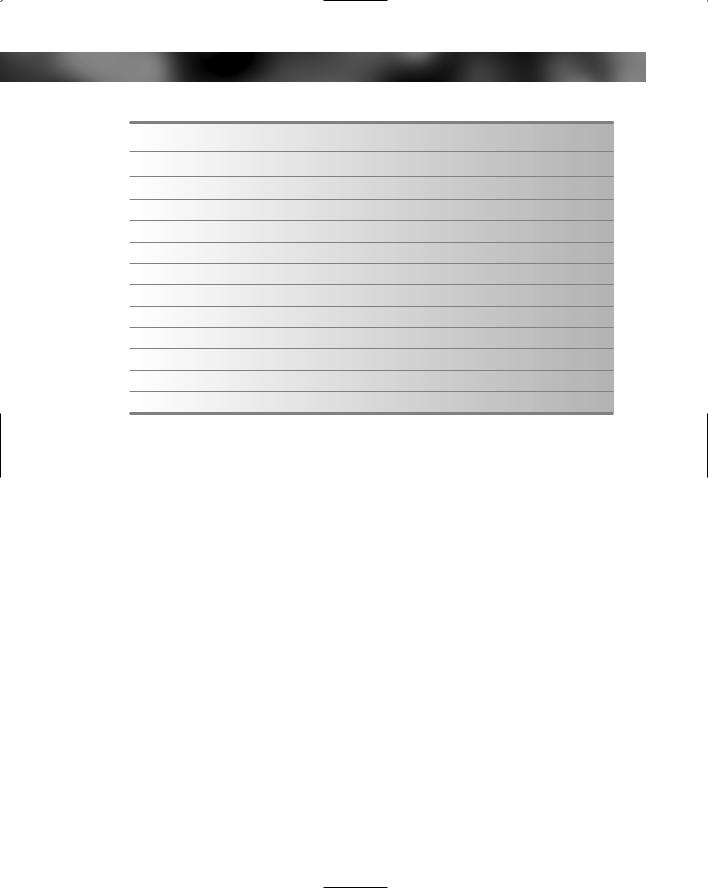
150 Part I — Customizing Your System
Table 6-1 FreeShade Keyboard Shortcuts |
|
Keys |
Result |
ALT 5 on num pad |
Rollsup/unrolls window |
ALT “ ” on num pad |
Displays FreeShade properties |
CTRL ALT “-” on num pad |
Closes FreeShade |
ALT 1 on num pad |
Moves window to lower-left of screen |
ALT 2 on num pad |
Moves window to bottom of screen |
ALT 3 on num pad |
Moves window to lower-right of screen |
ALT 4 on num pad |
Moves window to left of screen |
ALT 6 on num pad |
Moves window to right of screen |
ALT 7 on num pad |
Moves window to top-left of screen |
ALT 8 on num pad |
Moves window to top of screen |
ALT 9 on num pad |
Moves window to top-right of screen |
2.After you have installed FreeShade, you will have two icons on your desktop, one that will start the app, and one that will stop it. Click the FreeShade icon to start up FreeShade. Nothing visually will happen, but when you double-click a window you will notice that it now rolls up.
3.If you ever want to close FreeShade, just click the Stop icon that is located on your desktop or in the Start Menu.
FreeShade also offers a few other enhancements that affect how the window is sized. In order to use the other enhancements, you will have to use special keyboard shortcuts. Refer to Table 6-1 for a list of the keyboard shortcuts and what they will do.
Fine-Tuning ClearType
One of the best features of Windows XP is the new ClearType font smoothing engine. This new font smoothing feature uses a graphic technique known as anti-aliasing, which smoothes all of the rough edges of the fonts on the screen and greatly improves the look of Windows XP for users of LCD flat panel monitors. If you are an owner of a LCD monitor, you should definitely turn on this feature, as it will make your screen look amazing. Figure 6-12 shows a comparison between when the feature is turned on and when it is turned off. The image on the bottom, which has ClearType enabled, may look a little blurry on the page, but on a LCD the image looks very sharp.
If you do not have ClearType enabled, follow these steps to get it turned on:
1. Right-click the desktop and select Properties.
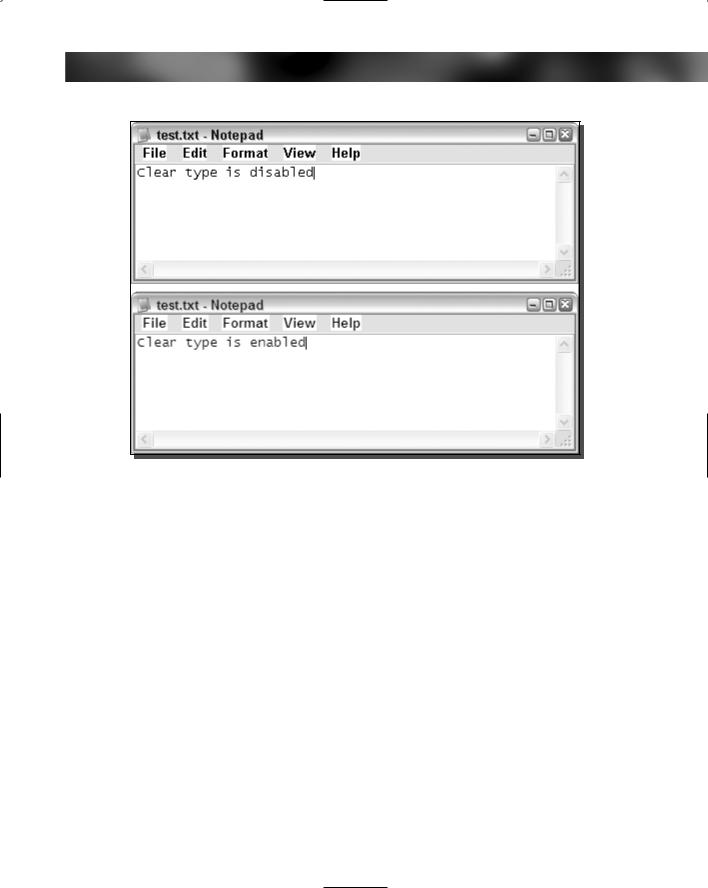
Chapter 6 — Exploring Other Windows Enhancements 151
FIGURE 6-12: Normal font smoothing versus ClearType.
2.Click the Effects button on the Appearance tab.
3.In the second drop-down box, select ClearType under Use The Following Method To Smooth The Edges Of The Screen Fonts.
4.Click OK to save your changes.
5.Select OK once more to close Display Properties and to apply the new settings.
Now that you have ClearType turned on, it’s time to fine-tune its settings. Some users complain that the new ClearType feature causes the text on their screen to look a little blurry compared to standard font smoothing. ClearType was designed to smooth the fonts on the screen replacing jagged edges. If you are one of the users that do not like how ClearType looks, with the help of a very cool online tool, you can customize how ClearType looks. Using the online tool that is developed by Microsoft, it is possible to change the darkness and thickness of the text. This will allow you to make the text that appears on your monitor look crisper. Follow these steps to fine-tune your ClearType settings:
1.Open up Internet Explorer and browse to www.microsoft.com/typography/ cleartype/.
2.Navigate to the ClearType Web interface to fine-tune the settings located on the right side of the Web page.

152 Part I — Customizing Your System
3.As the ClearType Web interface is loading, you will be prompted to install the ClearType Tuning Control. Click Yes on your screen so that this component will be installed.
 With the release of Windows XP Service Pack 2, Internet Explorer was locked down to provide better security. If the ClearType Tuning Control does not automatically download and install, then you may need to adjust your ActiveX security settings in Internet Options.
With the release of Windows XP Service Pack 2, Internet Explorer was locked down to provide better security. If the ClearType Tuning Control does not automatically download and install, then you may need to adjust your ActiveX security settings in Internet Options.
4.On the step 1 screen, click Next to move to the next step, because you already have ClearType started.
5.On step 2 of the ClearType Tuning Control, you have to select if your monitor uses a red-green-blue (RGB) color scheme or a blue-green-red (BGR) scheme. All LCD computer monitors are made up of very tiny vertical lines of alternating colors. There are two different ways that monitors lay out the lines on the screen. Some monitors alternate red, green, and blue lines (RGB) on the screen, whereas other monitors alternate blue, green, and red lines (BGR). ClearType has recently been updated to also support the BGR format, and now users that have BGR monitors can select this feature. Don’t know which one to select? It’s easy; just select the option that looks sharper on your screen and then click Next.
6.On step 3, you will be shown six different settings that you can choose to fine-tune ClearType. Just select the item that looks best to you and click Finish.
Your new settings will instantly go into effect. If you do not like the changes, just follow the preceding instructions and start over. If you notice that the coloration of some of the characters on your screen is a little strange, specifically the I’s, then you might have the wrong screen mode selected. Follow the preceding instructions again and select the other color scheme.
If you don’t own a LCD monitor, you can still try to use ClearType. It will not create any problems but also might not help out all that much either. I recommend that you still experiment with it. You might be surprised.
Branding Windows XP
Did you ever notice how when you buy a computer from one of the big computer manufacturers your computer has their name and logo in many different parts of the computer? How would you like to replace their branding information with your own? Or if you built your own computer, why not brand it? These next two sections will show you how you can brand the system information screen and Internet Explorer.
Branding system properties
Every time you right-click My Computer and select Properties or click the System applet item in the Control Panel, you will be shown branding information on the general information screen of System Properties. This screen is usually customized by computer manufacturers to display their logo, as well as general information such as the model number and support notes. If you would like to change this information or brand a PC that you made yourself, this section
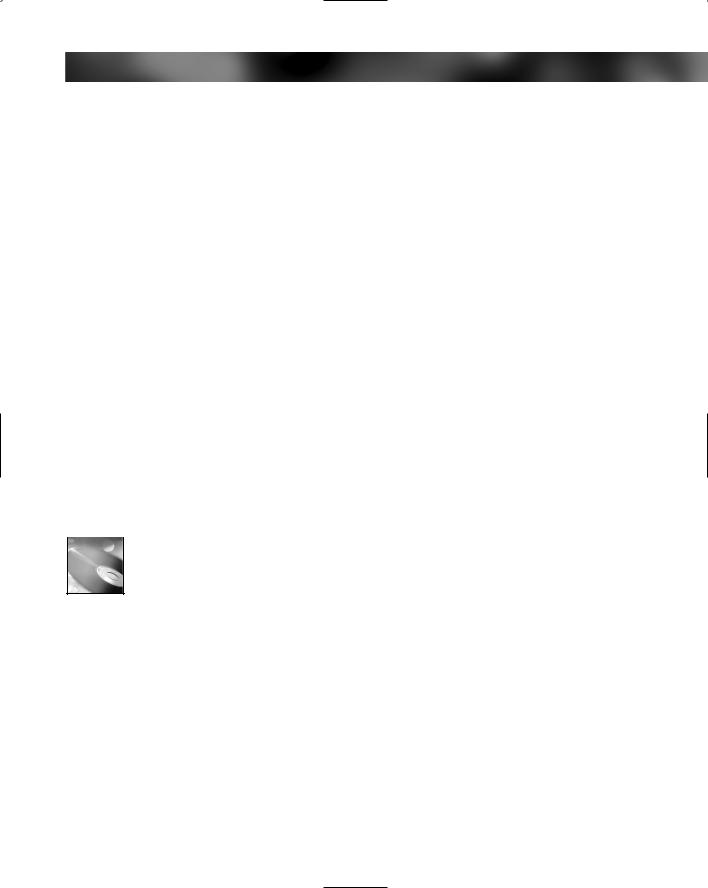
Chapter 6 — Exploring Other Windows Enhancements 153
will show you how to accomplish this in just a few easy steps. To get started, assume that your computer is not branded and that you are going to be doing this for the first time. If your computer was already branded, then instead of creating the files that I will mention, just replace them with your versions. Follow these steps to do branding of your own:
1.There are two parts to branding your computer. The first part is creating an image to be displayed on the System Properties General tab. The image must be a bitmap and be no larger than 180 115 pixels. Once you have created your file, name it oemlogo.bmp and save it in C:\Windows\System32 folder.
2.Now that you have to get the logo out of the way, you will need to create a file with all of the text that you want to appear on the screen next to it. To do this, open up Notepad and key in the following code. Feel free to replace the text to the right of the with anything you want.
[General] Manufacturer StevePC Model HighwaySpecial 18G [Support Information]
Line1 No support is provided in English Line2 Guaranteed to work for at least 5 days Line3 87% restocking fee for all returns
Line4 Returns only accepted at Kuznetsk warehouse in Russia
3.Once you have your text in the right format, click the File menu bar item and select Save As.
4.Save the file as oeminfo.ini in your C:\Windows\System32 folder. Make sure to change the Save As file type to All Files instead of .txt so that the file is saved with the correct file extension.
 A copy of the oeminfo.ini file can be found in the Chapter 6 folder on the book’s companion CD-ROM.
A copy of the oeminfo.ini file can be found in the Chapter 6 folder on the book’s companion CD-ROM.
If everything went well, the next time you look at the System Properties screen, you should see your new branding information. Figure 6-13 is an example of what my branded screen looks like.
Branding IE
Internet Explorer is another part of the operating system that is often branded by computer manufacturers and Internet Service Providers. Not a lot can be done to brand Internet Explorer other than to add some text to the title bar of the browser. Back when dialup Internet was the only means of accessing the Net, I remember trying to figure out how to remove text that the dialup software distributed from providers such as CompuServe and Prodigy. Every time I would open up Internet Explorer, it would say Prodigy Online along with Microsoft Internet Explorer as the title of the window. Back then, the only solution for getting rid of the excess type was to manually hack the registry and fix the entry responsible for storing the name of the
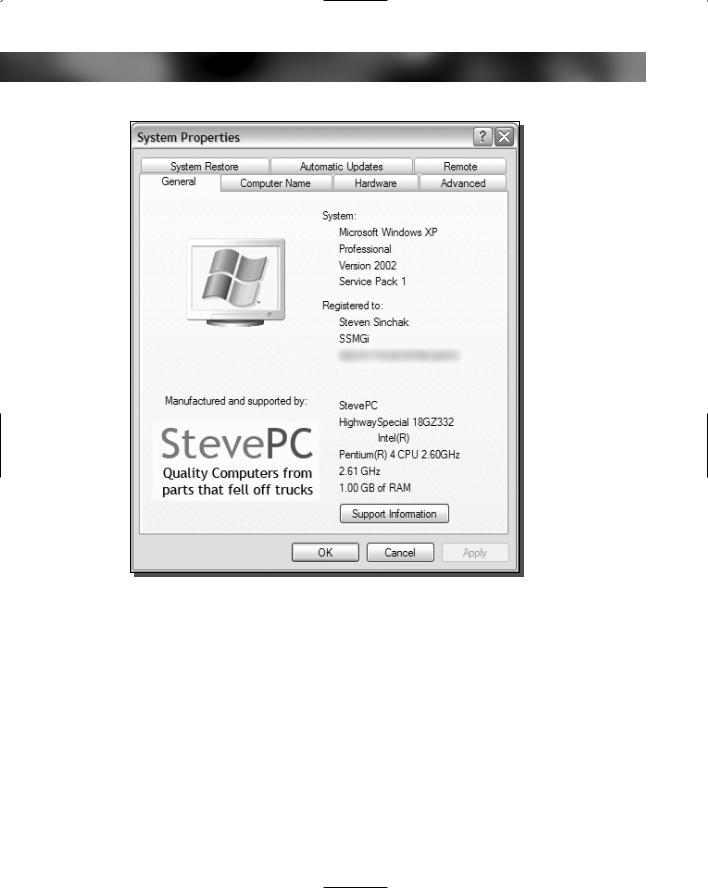
154 Part I — Customizing Your System
FIGURE 6-13: Creating your own branded system screen.
window. Now a really great utility is available, called Rebrand, by Advent Code, that greatly simplifies the editing of the Internet Explorer window title. Follow these steps to edit your title bars:
1.Visit Advent Code’s Web site at www.adventcode.net/rebrand.html and download a copy of Rebrand. Then, run the file and extract the files to your computer.
2.Start up Rebrand by browsing to the directory from which you extracted it and clicking on rebrand.exe.
3.To change the title of Internet Explorer, just type new text in the top box, as shown in Figure 6-14, and then click the Apply button to save your changes.
Once you are finished editing the title and have clicked the Apply button, you can close Rebrand. Your changes should take effect immediately.
